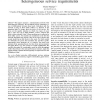Free Online Productivity Tools
i2Speak
i2Symbol
i2OCR
iTex2Img
iWeb2Print
iWeb2Shot
i2Type
iPdf2Split
iPdf2Merge
i2Bopomofo
i2Arabic
i2Style
i2Image
i2PDF
iLatex2Rtf
Sci2ools
INFOCOM
2003
IEEE
2003
IEEE
Pricing strategies under heterogeneous service requirements
— This paper analyzes a communication network with heterogeneous customers. We investigate priority queueing as a way to differentiate between these users. Customers join the network as long as their utility (which is a function of the queueing delay) is larger than the price of the service. We focus on the specific situation in which two types of users play a role: one type is delay-sensitive (‘voice’), whereas the other is delay-tolerant (‘data’); these preferences are reflected in their utility curves. Two models are considered: in the first the network determines the priority class of the users, whereas the second model leaves this choice to the users. For both models we determine the prices that maximize the provider’s profit. Importantly, these situations do not coincide. Our study uses elements from queueing theory, but also from microeconomics and game theory (e.g., the concept of a Nash equilibrium). We conclude the paper by considering a model in which through...
| Added | 04 Jul 2010 |
| Updated | 04 Jul 2010 |
| Type | Conference |
| Year | 2003 |
| Where | INFOCOM |
| Authors | Michel Mandjes |
Comments (0)

